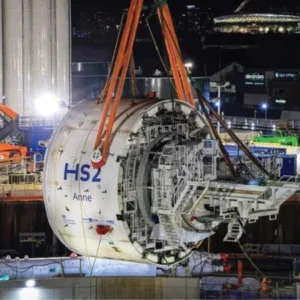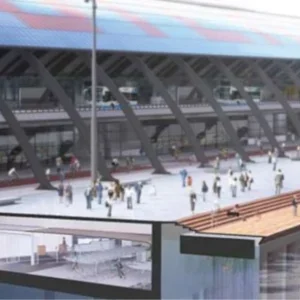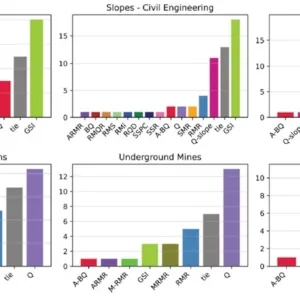There has been no extension to the city of Lyon’s underground transportation network for more than 10 years. And for good reason. The local geological conditions are not conducive to tunnelling, making projects far from straightforward. But necessity is the mother of invention, and the challenging conditions have forced the industry to innovate. This explains why Lyon has witnessed some historical breakthroughs and the emergence of innovative tunnelling technology, such as the first mixshield TBM in France to pass beneath the Saône and Rhône rivers for the Line D; and the improvements made to the hyperbaric intervention process during the construction of the ring road of the Boulevard Périphérique Nord de Lyon (BPNL) project.
The Metro B line extension to HLS (South Lyon Hospital) has also provided its fair share of challenges: geological investigations carried out upstream of the construction highlighted the lack of a matrix within the alluvium, which comprised almost nothing but pebbles and cobbles. These layers of very high permeability are located beneath the most densely developed area of the project where buildings comprise a regional type of traditional cob that does not tolerate deformations.
Typically, the use of a slurry pressurised TBM would lead to fluid loss, poorly managed confinement pressure and eventually excessive surface deformation, with the potential for sinkhole formation.
The grain size distribution of the alluvium is at the limit of feasibility based on the application range of a pressurised TBM, and required the contractor to develop mitigation measures.
On the other hand, the coarse nature of the alluvium created the opportunity to instigate a circular economy by reusing the excavated material. With its beneficial mechanical properties, it was reused not only directly on site but also locally within the construction industry.
METRO B EXTENSION
The previous 1.8km extension of metro Line B from Stade de Gerland towards the Orsel shaft, crossing under the Rhône River and via the Oullins Gare station, became operational in December 2013.
The latest project is a 2.4km extension which is being excavated from South to North. It will connect the Pahls launch shaft in Saint-Genis Laval to the existing Orsel shaft, via two new stations: Hôpitaux-Lyon-Sud (HLS) and Oullins Centre (OCE). The extension also includes an intermediate shaft for ventilation and emergency access to the Chemin du Grand Revoyet (PGRE).
CONTRACT AWARD
The €138bn (US$163bn) contract MBHLS-GC01 was awarded to the Implenia/Demathieu & Bard joint venture in July 2018. Design of the TBM by Herrenknecht, in collaboration with the consortium, began in September 2018, with a factory assembly start in April 2019 and a successful factory acceptance test in August 2019. The 9.75m outside-diameter machine excavated a single-bore tunnel to house a twin-track configuration.
Construction of the launch shaft employed diaphragm walls and took place between October 2018 and September 2019. After 2.5 months of assembly on site, the first turn of the cutterhead took place on 29 November 2019. The TBM’s arrival at the Orsel shaft took place on 15 May, 2021, with the extended line scheduled to open in 2023.
GEOLOGY
The tunnel alignment runs through a fluvio-glacial alluvial complex. It follows a valley with superficial sandy-silty deposits (Fx) and at depth, a pebble and cobble horizon locally devoid of fine-grained particles (Fv). Both formations contain erratic metric blocks of glacial origin forming hard spots that can damage cutting tools and necessitate frequent hyperbaric interventions. The granite basement (and mixed fronts) is intercepted when crossing the ‘Patinière’ hill and arriving at the Orsel shaft.
The coarse nature of the pebbles and cobbles horizon was problematic in maintaining continuity of confinement pressure. The lack of water table counterpressure over most of the project adds another challenge: the overpressure (compared to the existing hydrostatic pressure) is equal to the confinement pressure. There is a high risk of losing drilling fluid through the porous ground and subsequent loss of confinement pressure.
The built-up area of Oullins was encountered along the final 1,200m of excavation. The most sensitive area, where settlement control is essential, had coincided with the most unfavorable ground for the confinement of TBM excavation.
Granulometric curves of the different horizons encountered along the route show that the Fv alluvium is at the feasibility limit of TBM excavation (after Thewes 2007 and 2009). Half of the Fv alluvium samples were not in the earth pressure (EPB) field of application where conditioning difficulties are anticipated for the creation of a plastic EPB paste. Yet this is essential for applying the required confinement constraints to the ground, as well as the creation of a pressure gradient in the screw. Excavation in EPB mode would require a substantial input of filler to recreate a plastic paste, but this would be a technically heavy and costly solution. The use of a slurry pressure balance (SPB) TBM could lead to face stabilisation difficulties and require the addition of filler.
CONFINEMENT PRESSURE CONTROL
The consortium’s response to these geological challenges was based on a research programme undertaken at tender stage. It aimed to develop technical and innovative excavation slurries to limit losses in the ground and to ensure confinement control. The use of a technical slurry is possible thanks to the latest variable density (VD) TBM technology. Hydraulic transport allowing the revaluation of excavated material was an additional factor in favour of a VD TBM.
Organic clogging products sourced locally from agriculture and forestry industries rapidly became the favoured option to prevent mechanical clogging. Arguments for this initiative included efficiency, cost, environmental aspects and slurry treatment plant considerations. Those products also have less impact on mud quality parameters and do not increase its density.
The final stage of the research programme was to test technical slurry formulas under pressure against a sample of Fv alluvium in a permeameter. Two sizes of permeameters were used: a standard permeameter with a 300mm diameter for roughing tests; and a second permeameter, 800mm in diameter and three metres long designed specifically for the project. The latter can be tilted horizontally to verify the stability of a vertical front under pressure (area of 0.5m2 instead of 0.07m2 previously). It also permits the replacement of mud pressure by air pressure so as to simulate a hyperbaric intervention.
A standard sample for reproducible experiments was created using soil samples of Fv alluvium washed, sieved and cleared of particles smaller than 5mm. Compared to other soil samples, the granulometric curves are conservative in order to create the most unfavorable case that could be encountered during excavation. The standard sample has a permeability greater than 1 x 10-2m.s-1.
It has finally been possible to maintain 2.5bars of pressure independently of the clogging products concentration (reducing the concentrations increases slurry loss, but clogging is still effective after some time and a membrane cake is created on top).
This solution is compelling not only from a technical and economic point of view but also from an environmental one since it falls within the scope of by-product recycling. Also, the source of the clogging products is located less than 300km from the site.
Exiting the Patinière granitic hill, and in addition to the difficulty inherent in a transition zone, was a key moment in the project where the TBM encountered the Fv alluvium with high porosity across the whole face for the first time. It corresponds also to the first instance of dwellings at the surface.
Given the lack of precedent, an observational approach was adopted: first – and very carefully – with instructions for continuous minimal injections of technical slurry, even during excavation; then, only during ring building and maintenance stops; and finally, once the robustness of the system had been ensured and pilots became familiar with the methodology, the supply of clogging technical mud was made according to losses into the ground. In the nominal phase, injection directly into the mixing chamber via the secondary circuit took place according to the variations in level in the bubble chamber.
Before each hyperbaric maintenance stop, the replacement of drilling mud by clogging technical mud was carried out and a cake-pressing time was observed before switching to air pressure. During successive operations, re-caking (filling the chamber and pressing for thirty minutes to one hour) sometimes occurred when there were significant air losses. The quality of the hyperbaric intervention cake essentially depends on the terrain and the pressing time allocated, permitting the formation of a membrane on the excavation face.
The ability to manage slurry losses independently of the overpressure applied to the ground made it possible to implement the observational method for the management of surface deformations. An overpressure, compared to the calculation notes, could be implemented in order to adjust surface settlements. Settlement in the Fv alluvium zone was limited to 3mm. A volume loss of around 0.15% was observed.
RECYCLING EXCAVATED MATERIAL
Recycling excavated material during tunnelling projects is now a common occurrence. Regularly mentioned in calls for tenders but often abandoned in the heat of the moment, it is nevertheless an innovation for the construction site of an underground subway line.
In Lyon, the joint venture has set up an on-site recovery process, with screening, drying and mixing installations to produce recycled material for tail-void grouting and tunnel backfilling (up to 1.60m thick). Cement-free, compacted sand/gravel mix reused as backfill for a railway tunnel is a first. This virtuous circular economy with dual environmental and economic benefits was made possible by the existence of a favorable geology, hydraulic mucking-out of a variable-density TBM, efficient separation process at the slurry treatment plant and dedicated procedural studies.
Anticipated at an early stage, site installations included two conveyors at the slurry treatment plant to separate sand and gravels, additional screening units, mixing and storage shelters, and conveyors to the tunnel entrance. On the other hand, the slurry enriched in clay is treated using a filter press and centrifuge to reduce the water content before evacuation.
High quality assurance/control standards were implemented with the set-up of an applied R&D programme and assay laboratory onsite. Excavated material was first characterised, including granulometry, resistance to fragmentation and abrasion (LOS, MDE), sensitivity to water (VBS, absorption), then compaction tests (Proctor CBR/IPI) and real-scale trials to reach a satisfying sand/gravel mix formula and compaction methodology. After compaction in tunnel, the soil-bearing capacity and density are verified with an EV2 plate load test (averaging 100MPa) and gamma densimeter measurements. Once approved, 200mm of concrete is cast on top.
Tunnel backfilling began during TBM excavation without impacting traffic. Loaded MSVs weighing up to 100t conveyed supplies on compacted gravel without any incidents. Average advance rate was 20m/ day. The material is composed at 75% of 0/100mm, high-quality glacial/alluvial material from site, mixing rounded pebbles and cobbles (quartzite, minor granite/ limestone) and sand. It was necessary to add around 25% of externally-sourced, dry sand to adjust the water content to the optimum Proctor. The main constraints in implementation were the limited space onsite, vibration tolerances in the tunnel and controlling the material’s water content.
At this stage, recycling reached 4,000m3 of sand in tail-void grout and 13,000m3 of sand/gravel mix in tunnel backfill (75% progress). These volumes represent 10% of the total extracted material, saving more than 1,100 truck journeys. Backfilling with compacted gravel up to a thickness of 1.6m is saving 7m3 of concrete per tunnel metre, or 16,000m3 of concrete in total. Moreover, 50% of the sand/gravel evacuated offsite is reused on construction sites, the other 50% (including filter-press cakes) is used in quarry rehabilitation within a 50km radius. Considering the reduction in transport, and concrete’s highly carbonated life-cycle (especially cement), this circular economy has a significant impact on reducing the project’s carbon footprint.
CONCLUSION
Technical slurry ends up having multiple benefits, making excavation in challenging geology more efficient and safer. No disadvantages or counter performances were noticed during its first implementation on the 2.4km drive.
Geological formations of coarse soils with a matrix deficit are challenging for tunnelling. The usual excavation methods suffer from their unstable behaviour and their high permeability. Associated with the VD-TBM technology, the technical slurry that was employed on the MBHLS project is an efficient, cost effective, safe and sustainable solution to adopt for such a project. This innovative method extends the feasibility of TBM applications to accommodate coarser soils.






